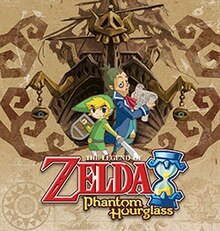Our website is made possible by displaying online advertisements to our visitors.
Please consider supporting us by disabling your ad blocker.
The Legend of Zelda: Phantom Hourglass
| The Legend of Zelda: Phantom Hourglass | |
|---|---|
 North American box art | |
| Developer(s) | Nintendo EAD |
| Publisher(s) | Nintendo |
| Director(s) | Daiki Iwamoto |
| Producer(s) | Eiji Aonuma |
| Designer(s) | Michiho Hayashi |
| Programmer(s) | Shiro Mouri |
| Writer(s) | Hidemaro Fujibayashi[1] |
| Composer(s) |
|
| Series | The Legend of Zelda |
| Platform(s) | Nintendo DS |
| Release | |
| Genre(s) | Action-adventure |
| Mode(s) | Single-player, multiplayer |
The Legend of Zelda: Phantom Hourglass[a] is a 2007 action-adventure game developed and published by Nintendo for the Nintendo DS handheld game console. It is the fourteenth installment in The Legend of Zelda series and the direct sequel to the 2002 GameCube title The Wind Waker. Phantom Hourglass was released worldwide in 2007, with the exception of South Korea in April 2008. The game was re-released for the Wii U via the Virtual Console service in the PAL region in November 2015, in North America in May 2016, and in Japan in August.
The game features 3D cel-shaded graphics with an overhead camera perspective, employs controls involving the console's touchscreen and microphone, and took advantage of the Nintendo Wi-Fi Connection for online play until the service was discontinued in 2014. The game's story follows that of The Wind Waker, focusing on series main protagonist Link's journey to save his friend Tetra from the story's main antagonist, Bellum, with the help of Captain Linebeck and his ship, the S.S. Linebeck.
Phantom Hourglass received critical acclaim, with praise for its control scheme, world design, and graphics, while some criticized its online features, which were considered too simple. The game received several video game industry awards, including the Nintendo DS Game of the Year award from GameSpot, GameSpy, and IGN. Phantom Hourglass was the best-selling game in its first month in Japan, with 302,887 copies sold. In the United States, it was the fifth-best-selling game in the month it debuted, with 262,800 copies sold. 4.13 million copies of Phantom Hourglass were sold worldwide by March 2008.[2] A sequel, Spirit Tracks, was released in December 2009.[3]
- ^ "The Legend of Zelda: Phantom Hourglass development staff interview". nindori.com. Nintendo DREAM. August 2007. Archived from the original on September 13, 2007. Retrieved May 30, 2010.
だから今回は、ストーリーを書いた藤林がいちばん苦労したかも?/ So this time, it might have been very hard for Mr. Fujibayashi who wrote the story.
- ^ Cite error: The named reference
mar08was invoked but never defined (see the help page). - ^ Cardoso, Jose (May 12, 2016). "The Legend of Zelda: Phantom Hourglass joins the Wii U Virtual Console lineup". GameZone. Archived from the original on June 17, 2016. Retrieved May 28, 2016.
Cite error: There are <ref group=lower-alpha> tags or {{efn}} templates on this page, but the references will not show without a {{reflist|group=lower-alpha}} template or {{notelist}} template (see the help page).
Previous Page Next Page
ذا ليجند أوف زيلدا: فانتوم آورغلاس Arabic ث ليجيند اوف زيلدا: فانتوم هورجلاس ARZ The Legend of Zelda: Phantom Hourglass AST The Legend of Zelda: Phantom Hourglass Catalan The Legend of Zelda: Phantom Hourglass Danish The Legend of Zelda: Phantom Hourglass German The Legend of Zelda: Phantom Hourglass Spanish The Legend of Zelda: Phantom Hourglass Finnish The Legend of Zelda: Phantom Hourglass French The Legend of Zelda: Phantom Hourglass GL


